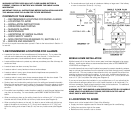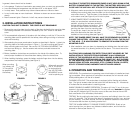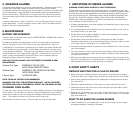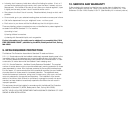
•In leaving, don’t open any inside door without first feeling its surface. If hot, or if
you see smoke seeping through cracks, don’t open that door! Instead, use your
alternate exit. If the inside of the door is cool, place your shoulder against it, open
it slightly and be ready to slam it shut if heat and smoke rush in.
•Stay close to the floor if the air is smoky. Breathe shallowly through a cloth, wet if
possible.
•Once outside, go to your selected meeting place and make sure everyone is there.
•Call the fire department from your neighbor’s home - not from yours!
• Don’t return to your home until the fire officials say that it is all right to do so.
There are situations where a smoke alarm may not be effective to protect against fire
as stated in the NFPA Standard 72. For instance:
a) smoking in bed
b) leaving children home alone
c) cleaning with flammable liquids, such as gasoline
Further information on fire safety can be obtained in a pamphlet titled “IN A
FIRE SECONDS COUNT” published by the NFPA, Batterymarch Park, Quincy,
MA 02269
9. NFPA REQUIRED PROTECTION
The National Fire Protection Association’s Standard 72 reads as follows:
2-2.1.1.1 Smoke alarms shall be installed outside each separate sleeping area in the
immediate vicinity of the bedrooms and on each additional story of the family living
unit, including basements and excluding crawl spaces and unfinished attics. In new
construction, a smoke alarm shall be installed in each sleeping room.
A-2.5.2.1 Smoke Detection - Are More Smoke Detectors Desirable? The required
number of smoke alarms might not provide reliable early warning protection for those
areas separated by a door from the areas protected by the required smoke alarms.
For this reason, it is recommended that the householder consider the use of addition-
al smoke alarms for those areas for increased protection. The additional areas
include the basement, bedrooms, dining room, furnace room, utility room, and hall-
ways not protected by the required smoke alarms. The installation of the smoke
alarms in the kitchen, attic (finished or unfinished), or garage is normally not recom-
mended, as these locations occasionally experience conditions that can result in
improper operation.
This equipment should be installed in accordance with the National Fire Protection
Association’s Standard 72 (NFPA, Batterymarch Park, Quincy, MA 02269).
NOTIFY YOUR LOCAL FIRE DEPARTMENT AND INSURANCE COMPANY OF YOUR
SMOKE ALARM INSTALLATION.
10. SERVICE AND WARRANTY
If after reviewing this manual you feel that your smoke alarm is defective in any
way, do not tamper with the unit. Return it for servicing to: Fyrnetics, Inc., 1055
Stevenson Ct./Ste 102W, Roselle, IL 60172. (See Warranty for in-warranty returns)








